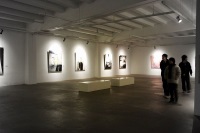
Beijing's prominent art district is home to 798 Space, an art gallery housed in a former electronics factory that built components for China's first atomic bomb and early satellites. The gallery is large and airy, capable of comfortably holding more than a thousand people, providing an unusual and stimulating background for the modern art on display. Exhibiting the latest in contemporary Chinese art in its lofty viewing rooms, 798 Space is a visual delight for any traveller. Besides regular national and international exhibitions, 798 Space also hosts corporate and commercial events like fashion shows, product launches, conferences, and fairs. Within the gallery there is a film and video viewing area and a tempting gallery bookshop. There is also space for eating, relaxing and socialising, in a colourful little restaurant within the gallery.The art precinct itself is dotted with avant-garde statues, charming coffee shops and noodle bars, and a plethora of other wonderful art galleries to visit. Art lovers will need at least a day to explore the trendy neighbourhood.
Address : 2 Jiuxianqiao Road, Dashanzi Art District, Chaoyang District
E-mail : [email protected]
Website : www.798district.com
Telephone : +86 10 5978 9798
Opening times : Open daily from about 10.30am until about 7.30pm.
Admission : Free
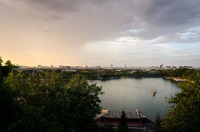
A place of tranquillity and grand imperial beauty, the Beihai Park is one of the great attractions of Beijing. The park is centrally located and close to the Forbidden City and Jingshan Park, providing a peaceful, natural haven after a long morning of busy sightseeing. Beihai Park is one of the oldest and best preserved imperial gardens in China; its history extends over 1,000 years to the ancient Liao dynasty, which ruled between 916 and 1125. Built up through five dynasties, the park is an emblem of old-world China, designed according to the ancient Chinese art of landscaped gardens with artificial hills, colourful pavilions, and intricate temples. Kublai Khan lived in what is now the Circular City of Beihai Park, and the Tibetan-style White Dagoba, built in 1651 on Jade Island, is a landmark for both Beihai Park and Beijing, having been constructed on the suggestion of a famous Tibetan Lama priest, NaomuHan. Apart from the famous White Dagoba and the Circular City, landmarks within Beihai Park include Hao Pu Creek Graden, the Quiet Heart Studio, Nine-Dragon Screen, and the Five-Dragon Pavilions. The Fangshan Restaurant, on the northern shore of the lake, is also worth a visit.
Address : Wenjin Jie 1, Xicheng Qu
Website : www.beihaipark.com.cn/en
Telephone : (0)10 6403 3225
Transport : Underground rail to Tiananmen Xi, then bus number 5.
Opening times : Open daily 6.30am-9pm (April to October); 6.30am-8pm (November to March).
Admission : CNY 10 (April to October), and CNY 5 (November to March).
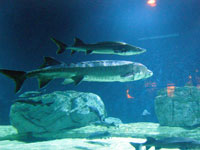
Located within the Beijing Zoo, the Beijing Aquarium is one of the world's largest inland aquariums. Its interactive exhibits provide an immersive experience that cannot fail to delight, such as an imaginative Amazon rainforest, complete with piranhas and pandas, as well as an exquisite shark aquarium where the brave can plunge into the tank with these infamous predators. Other attractions include whales and a number of rare or endangered fish. Families flock to see the dolphin shows at 11am and 3pm but, although these displays are a consistent favourite with kids, they are conducted in Chinese only.A boat from the canal south of the aquarium runs to the Summer Palace, giving visitors the opportunity to sightsee while en route to the attraction. The Beijing Aquarium offers a great mix of entertainment and education and is the perfect departure from more traditional cultural and historical tourism. For those travelling with children in Beijing, the aquarium is sure to delight the whole family. The fact that it is wonderful no matter what the weather also makes it a useful venue to have on the travel itinerary.
Address : 18 Gaoliangqiao Byway, Haidian District.
Website : www.bj-sea.com
Telephone : (0)10 6217 6655
Transport : Bus 4 (from Qianmen)
Opening times : 9am-5.30pm (summer); 10am-4.30pm (winter).
Admission : CNY 175 adults (concessions available for children)
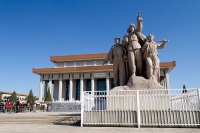
Although Chairman Mao Zedong of the Central Committee of the Communist Party of China requested to be cremated, it was decided hours after his death in 1976, that he would be instead be embalmed. It is said that after his death, doctors pumped him so full of formaldehyde that his body swelled excessively. After draining the corpse and getting it back to a suitable state, they created a wax model of Mao Zedong, as a backup. It is unknown today which version of the Great Helmsman is on display at the Mausoleum at any given time.The Mausoleum itself was built in 1977 on the prior site of the Gate of China, the main gate of the Imperial City during the Ming and Qing dynasties. On the first floor people can visit the tomb of the leader himself, and on the second floor there is a museum of sorts dedicated to six great communist leaders, including Mao himself. Those interested in visiting the Mausoleum can join the long line of visitors outside the building every day. Visitors should remember to dress respectfully and maintain silence in the mausoleum, as the site is a place of worship more than a tourist destination. Those dressed in casual wear like vests and flip flops may be denied entry.
Address : South end of Tiananmen Square
Website : cpc.people.com.cn/GB/69112/113427/
Telephone : 010 6513 2277
Opening times : 7am-11pm, Tuesday to Sunday. The Memorial Hall may be closed for special occasions.
Admission : Free.
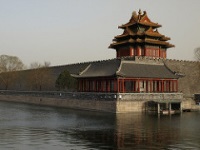
The impossibly majestic Forbidden City is a historical precinct situated in the heart of Beijing. Almost a city in its own right, the UNESCO World Heritage Site has been declared the largest collection of preserved ancient wooden structures in the world. The Forbidden City, called Gu Gong in Chinese, was the imperial palace during the Ming and Qing dynasties. It is the biggest and best preserved complex of ancient buildings in China, and the largest palace complex in the world. Construction of the palace complex began in 1407, and for 500 years this inner sanctum was off-limits to most of the world as the emperors lived in luxury, secluded from the masses, and surrounded by their families, court officials, servants, eunuchs, concubines, and other members of court. The Forbidden City and its centrepiece, the magnificent palace, have a permanent restoration squad that works continuously to keep the 800 buildings and 9,999 rooms inside the Forbidden City complex in perfect condition. The once Forbidden City is now open to all visitors, and is home to the Palace Museum, home to a priceless collection of ancient artefacts. The complex can get very crowded so it is best to go early in the morning to fully appreciate the layout of the place.
Website : www.dpm.org.cn/english/default.asp
Opening times : Daily 8.30am - 4.30pm (November to March); 8.30am - 5pm (April to October).
Admission : CNY 60 (April to October); CNY 40 (November to March)
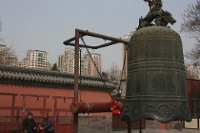
The Qing Temple is home to the Ancient Bell Museum (Gu Zhong Bowuguan) and is a great stop for travellers en route to the Summer Palace. The temple, originally known as 'Awakened Life Temple', apparently wasn't experiencing enough 'awakening' and a 47-ton bell, with a height of 22.7 feet (6.9m) was transported to the temple on ice sleds in 1743. The bell is inscribed with Buddhist Mantras on both the inside and outside of the body and features over 227,000 characters in all. The bell was often chosen by the emperors to pray for rain and blessings for the people of China and was one of three projects that Emperor Yongle of the Ming Dynasty (1368-1644) commanded after re-establishing Beijing as the capital; the other two were the Forbidden City and the Temple of Heaven. The bell is considered as an auspicious article in Chinese tradition and nowadays it is rung 108 times to begin the celebrations at grand ceremonies. There are a further 31 bells on display in the Ancient Bell Museum, most with tributes to various emperors inscribed on them. Like many tourist attractions in China, the written material in English is limited, but the temple is definitely still worth a visit.
Address : Bei San Huan Xi Lu 31A
Opening times : Open Tuesday to Sunday 9am - 4.30pm
Admission : CNY 20
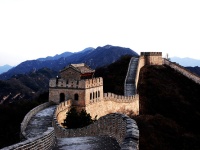
The Great Wall of China, a UNESCO World Heritage Site, is a perennial favourite among tourists, and with good reason. The magnificent Great Wall, stretching 4,000 miles (6,350km), was built in stages from the 7th century BC onwards, snaking its way across the mountains and valleys of five provinces in northern China as a mammoth defence bulwark against the neighbouring Manchurian and Mongolian peoples.Several sections of the wall, which has become the most prominent symbol of Chinese civilisation, can be viewed in the greater Beijing area. In Yanqing county, in northwest Beijing, is the 600-year-old Badaling Fortification, representative of the Ming dynasty sections of the Great Wall. Other sections can be seen at Jinshanling, Mutianyu, and Simatai. The more popular sections can be very crowded, but generally if travellers walk a little way they can escape the worst of it. There are some wonderful stretches of the wall to hike, such as the roughly six-mile (10km) section between Jinshaling and Simatai, but visitors should be careful about setting off alone as parts of the wall are unstable and unsafe. It is best for visitors to take their own water and snacks and to pack very warm clothes if planning to go in winter, because temperatures at the wall can be freezing. There are countless vendors, but their goods are usually very expensive and of questionable quality. It is illegal to remove stone from the wall and Chinese authorities are clamping down on the practice.
Website : www.mutianyugreatwall.net
Transport : To Mutianyu: Travellers can take the 916 bus from Dongzhimen station (in downtown Beijing) to Huairou, where they can take a minibus taxi to the wall.
Opening times : April to October 7am - 6pm; November to March 7.30am - 5.30pm
Admission : CNY 45 (adults); CNY 25 (children)
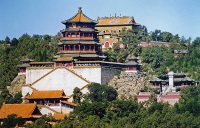
The magnificent Summer Palace at Kunming Lake, in northwest Beijing, was built in 1750 by the Emperor Qianlong, and continued to be an imperial residence until the Empress Dowager Cixi died in 1908. It is the largest and most well-preserved royal park in China, and has been declared a UNESCO World Heritage Site. The palace and stunning gardens are open to visitors, who enter through the East Palace Gate, pass through a grand courtyard into the Hall of Benevolent Longevity, the Hall of Jade Ripples, and the Hall of Joyful Longevity. Empress Cixi's private theatre in the Garden of Moral Harmony is a must-see, as is the long corridor that skirts Kunming Lake's northern shoreline to reach the marble boat, an elaborate two-storey structure of finely carved stone and stained glass. All in all the Summer Palace boasts not only famously beautiful grounds but also 3,000 man-made ancient structures, including mansions, temples, pavilions, bridges and towers. Once a place for weary royals to relax, the Summer Palace is now a sanctuary for travellers and, although it can get crowded, it always seems calmer and cooler than the rest of the city.
Website : www.summerpalace-china.com
Telephone : (0)10 6288 1144
Opening times : Daily 7am - 5pm (November to March); 6.30am - 6pm (April to October)
Admission : CNY 20 (November to March), CNY 30 (April to October)
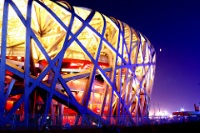
The Beijing National Stadium, also known as The Bird's Nest due to its appearance, was the hub of the 2008 Summer Olympic Games, hosting all of the track and field events as well the opening and closing ceremonies. The unique-looking steel support structures framing the stadium, weigh in at 110, 000 tons (99,790kg), making the stadium the largest steel structure in the world. The colossal structure was created using a web of steel frames converging in a grid formation. The visual effect is unique and impressive and it was designed to symbolise harmony between technology and nature. The stadium has reopened as a tourist attraction, and the public can tour the facilities, or visit the ski resort now housed inside during the Happy Snow season (ticket prices go up during the skiing season). The area surrounding the stadium complex comes alive in the evenings with music, hawkers and vendors. Even if visitors only go to have a look from outside, and decline to do the tour, it is well worth visiting The Bird's Nest. The best time of the day to visit is late afternoon to evening when the lights come on, creating an incredible effect.
Address : Olympic Green, Beijing
Website : www.n-s.cn
Transport : The entire Olympic park can be accessed via subway line 8.
Opening times : April to October 9am - 7pm; November to March 9am - 5.30pm.
Admission : CNY 50 for general admission; CNY 80 for VIP ticket.
For more than 20 years, Beijing's Underground City, a bomb shelter just beneath the ancient capital's downtown area, built in case of nuclear attack, has been virtually forgotten by Beijing locals, despite being rather famous among foreigners since its official opening in 2000. A sign near the entrance announces this rarely visited attraction a 'human fairyland and underground paradise'. Aside from some rather odd recent additions, the Underground City features factories, stores, guesthouses, restaurants, hospitals, schools, theatres, reading-rooms, a roller-skating rink and many other curious features, like a mushroom farm to provide food easily cultivated in darkness. On Mao Zedong's orders, it was built from 1969 to 1979 by more than 300,000 local citizens including school children, mostly by hand. The tunnels were initially intended to accommodate all of Beijing's six million inhabitants upon completion. Winding for over 18 miles (30km) and covering an area of nearly 53 square miles (85 sq km) from eight to 18 meters under the surface, the underground City includes more than 1,000 anti-air raid structures.
Address : Xi Damochang Jie 64
Transport : Metro: Qianmen (exit B)
Opening times : Open daily 9am - 4pm but appointments are by arrangement only and must be booked in advance.
Admission : CNY 20
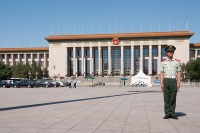
This famous square at the heart of Beijing attracts tourists not only with its pleasing design and views of numerous landmarks, including the famous painting of Chairman Mao, but also because it was the scene of so many historic events and is said to be the largest city square in the world. In the ancient imperial days, the square was a gathering place and the site of government offices, but more modern history, particularly the 1989 massacre of pro-democracy demonstrators, has made it a site of great political significance. Major rallies took place in the square during the Cultural Revolution when Mao Tse Tung reviewed military parades up to a million strong.The square is surrounded by several monuments, some ancient and some modern, including the former gates to the Forbidden City, the Gate of Heavenly Peace and Qianmen (the front gate), the Chinese Revolution Museum, and the Mao Mausoleum, where China's former leader lies preserved. There is also an underground walkway connecting Tiananmen Square with the Forbidden City. Like most big tourist attractions in China, it is best to try and go early in the day to avoid the masses (the square opens to visitors as early as 5am). Visitors in summer are advised to wear sunscreen or a hat, as there is little shade to be found.
Address : Dongcheng, Beijing
Opening times : Open all day.
Admission : Free to visit the square; CNY 15 to climb Tiananmen Tower.
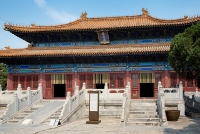
Built by the emperors of the Ming Dynasty of China, the majority of surviving Ming tombs are clustered near Beijing and easily reached on short excursions out of the capital. Thirteen emperors' mausoleums, dating from between 1368 and 1644 and collectively UNESCO-listed, can be seen in the Ming Tombs Scenic Area at the foot of Tianshou Mountain.Currently only three of the tombs are open to the public (Chanling, Dingling and Zhaoling) but this is more than sufficient as all the tombs are similar in design and the three that can be explored are arguably the most interesting. The Changling Tomb is the largest, oldest and best preserved, looming majestically at the end of the Sacred Way. The Dingling Tomb is the only one which has been properly excavated but tragically many of the artefacts and the remains of the emperor and empresses entombed in the mausoleum were destroyed during the Cultural Revolution. Even so, the excavated Underground Palace in Dingling is fascinating and some magnificent artefacts can still be viewed.Many operators in Beijing offer tours to the Ming Tombs, often combined with trips to the Great Wall and other nearby attractions. Visitors travelling independently will need to pay entry to each tomb separately.
Opening times : April to October 8am - 5.30pm; November to March 8.30am - 5pm.
Admission : April to October: Dingling CNY 65; Changling CNY 50; Zhaoling and Sacred Way CNY 35. November to March: Dingling CNY 45; Changling CNY 35; Zhaoling and Sacred Way CNY 25.
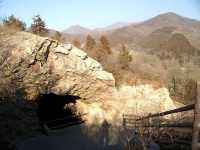
About 25 miles (40km) south of Beijing, in the Fangshan District, is the Zhoukoudian Cave, the source of the largest collection of Homo erectus fossils from any single site in the world. The fossils recovered from the cave represent about 40 individuals, most famous of which is a cranium element commonly known as the 'Peking Man', the world's earliest fire-using primitive man who lived between 200,000 and 700,000 years ago. German anatomist Franz Weidenreich studied the Peking Man remains in the 1930s and recognised 12 anatomical features that he believed Peking Man shared with modern man, a milestone in the study of palaeoanthropology.Visitors to the Zhoukoudian site on Dragon Bone Hill can view a comprehensive seven-room exhibition of fossils and artefacts depicting human evolution and the lifestyle of primitive man. The exhibits showcase fossils from all over China, allowing visitors to compare the different lifestyles of the primitive communities that have been discovered. They can also explore the cave where the Peking Man cranium and other Homo erectus remains were found. The area surrounding the caves has several animal sculptures and pleasant shady areas in which to relax. Travellers who go early might even have the site to themselves.
Address : Zhoukoudian, Fangshan
Website : www.zkd.cn
Telephone : 010 6930 1272
Transport : Bus 917 from Tianqiao station to Zhoukou Cun Lukou, before taking Fangshan Bus 38 to Yuan Ren Yi Zhi (Zhoukoudian Cave)
Opening times : April to October 8.30am - 4.30pm; November to March 8.30am - 4pm.
Admission : CNY 30 (adults), concessions available

Travel Guide powered by Word Travels, copyright © 2023 Globe Media Ltd. By its very nature information in this travel guide is subject to change at short notice and travellers are urged to verify information on which they're relying with the relevant authorities. Neither Globe Media Ltd nor Travel Vogue can accept any responsibility for any loss or inconvenience to any person as a result of information contained above.